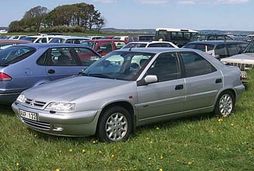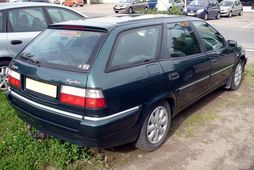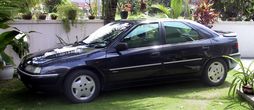The History Of Citroen Xantia

The Citroën Xantia is a Medium family car produced by the French automaker Citroën. First seen at the end of 1992, the car was produced between 1993 and 2001 . Citroën sold over 1.2 million Xantias during its 8 years of production. After production in Europe ended in early 2001, the SAIPA Corporation in Iran is still (as of 2007) producing them. The exterior styling of the Xantia was penned by Bertone.
The Xantia replaced the earlier Citroën BX and maintained the high level of popularity of that model, but brought the car more into the mainstream to compete harder with its rivals such as the Ford Mondeo, Nissan Primera, Rover 400, Toyota Carina E and Vauxhall Cavalier
It signalled that Citroën had learned from the reception given the staid Citroën ZX, introduced two years earlier and criticised by contemporary journalists for its lack of traditional Citroën flair in engineering and design. The Xantia addressed these concerns in an updated, conventionally attractive form.
Although the Xantia was not as dramatically styled as the Citroën BX, it was certainly more distinctive than its contemporaries such as the conservative Ford Mondeo and Opel Vectra. The Xantia also used the traditional Citroën hydropneumatic suspension system pioneered in the legendary DS. It was initially only available as a hatchback (liftback) (Berline), but an estate (station wagon) (Break) version built by Heuliez appeared in 1995.
In-line with PSA Group policy, the Peugeot 406, launched 2 years later, used the same floorpan, core structure and engines as the Xantia.
Sales in the UK were strong, though it was never able to match the success of established British favourites such as the Ford Mondeo or Vauxhall Vectra.
From an engineering perspective, the Xantia's biggest advance was the suspension. From launch, the more expensive models were available with an enhanced version of the XM's Hydractive, Hydractive II or H2, computer-controlled version of the hydropneumatic self-leveling suspension. This used extra suspension spheres to allow a soft ride in normal conditions, but taut body control during hard braking, acceleration or cornering. The Xantia features an innovation first seen on the ZX and then subsequently fitted to the facelifted XM - a programmed self-steer rear axle. On sweeping curves and tight bends alike, the rear wheels turn in line with the front wheels, sharpening responses and adding to driver pleasure.
In 1995, the Activa technology was introduced, which is an extension to the Hydractive II suspension, where two additional spheres and two hydraulic cylinders are used together with computer control to eliminate body roll completely. This technology is more broadly known as active suspension, and the Xantia Activa has exceptional road holding comparable to true sports cars.
The Xantia was the last Citroën to use a common hydraulic circuit for suspension, brakes and steering like the pioneering Citroën DS. It was also the last Citroën car that used the green LHM hydraulic fluid. Later cars, such as the C5, used LDS instead.
Power came courtesy of the familiar PSA XU-series gasoline engines, this time in 1.6, 1.8 and 2.0 displacements, a 2.0 16-valve version for the Xantia VSX, a turbocharged 2.0 engine, from 1995 onwards, a 1.8 16-valve and a 2.0 16-valve engine. In 1997, a 3.0 V6 engine was offered as top-of-the-line.
The popular XUD turbodiesel units in 1.9 (turbocharged: 92hp (69kW), low-pressure turbo: 75hp (56kW), or not: 71 hp) displacement proved to be the best-selling engine. The biggest diesel was a 2.1 TD with 109hp (81kW).
In 1998, PSA introduced the HDi direct injection turbodiesel (in two versions: 90hp (67kW) and intercooled 110 hp). For an economical diesel engine, the HDi offered the kind of throttle response normally seen in a gasoline engine and quiet high speed cruising at a top speed of 115mph (185km/ h). Acceleration was also good at 11.4 seconds from 0 to 60 mph.[citation needed] The 2.0 HDi has proved to be a very reliable engine, many taxis have gone over 250,000miles (400,000km).[citation needed]
The engines were very reliable, some pre 1997 models could do up to 300,000miles (480,000km),[citation needed] however in 1997 because of the new European law they had to put anti pollution systems on the XUD type Engine , it then suffered from failing conrods ( the 3rd conrod goes through the casing ) and the precombustion chambers crack and fall into to the cylinders ( when this is about to happen , the car does not start very well , chokes a lot ) This concerned all cars from PSA from 1997 until they fitted the HDI 2.0 engine.[citation needed]
Engine codes pre 1997 > D8A 1997> DHX / DHY
From Wikipedia, the free encyclopedia
More About Citroen Xantia



|